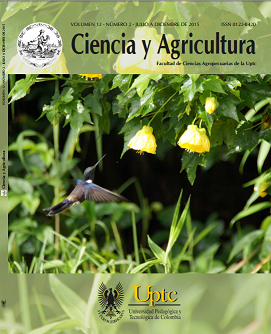Fatty acid content obtained from the guinea pig meat

Abstract
The study´s aim was to determine the fatty acid composition from the guinea pig meat. The study was conducted in the Riobamba City, Ecuador. The guinea pigs lines used were: Creole, Andean and Improved Peruvian. Itwas carried out a variance analysis forthe differences and measurements comparison according Duncan (P < 0.05). The total content of saturated fatty acids in this rodent meat did not registered statistical differences between the lines studied, with values of 37,1 1, 37,01 and 36,71 % for the guinea pigs Creole, Andean and improved Peruvian respectively.
Neither the content of monounsaturated acids reported statistical differences between the three lines, as they showed levels of 30.49, 29.26 and 31.44% respectively for Creole, Andean and Peruvian lmproved lines, with no statistical differences.
Levels of polyunsaturated fatty acids in the meat of this rodent were 13,30, 11,04 and 14,22% in Creole, Andean and Peruvian improved, having no statistical difference between them.
Keywords
guinea pigs, fatty acids.
References
- Santos, V. El cuy y su importancia en el mercado. Rev. Arch. Latinoam. Prod. Anim. 2007; 15(1): 216-217.
- Chávez, S. Tecnologías de producción y comercialización de carne de cuy procesada para el mercado nacional y de exportación. Servicios educativos, promoción y ayuda rural. Junín, Perú. 2013.
- Argote, F.; Cuervo, R. Agroindustrialización de la carne de cuy. Revista Científica Guillermo de Ockham. 2012; 10(2): 217-218.
- RTE-INEN 056. Carne y productos cárnicos. Instituto Ecuatoriano de Normalización. 2013.
- Castañeda, R. y Peñuela, L. Ácidos grasos en carne. Sitio Argentino de Producción Animal. Córdoba, Argentina. 2010.
- Valenzuela, A. Ácidos grasos con isomería trans I, su origen y los efectos en la salud humana. Revista Chilena de Nutrición. 2012;
- (3): 162-171, 2008.
- Ballesteros, M.; Valenzuela, L.; Artalejo, E.; Robles, A. Ácidos grasos trans: un análisis del efecto de su consumo en la salud humana, regulación del contenido en alimentos y alternativas para disminuirlos. Revista Nutrición Hospitalaria. 2012; 27(1): 54-64.
- Argote, F.; Velasco, R.; Paz, P. Estudio de métodos y tiempos para la obtención de carne de cuy (Cavia porcellus) empacada al vacío. Revista de la Facultad de Ciencias Agropecuarias. 2007; 5(2): 103-111.
- ISO-15304. Animland vegetable fats and oils. Analysis by gas chromatography of methyl esters of fatty acids International Standarization Organization. 2012.
- Morales, J.; Quemé, J.; Melgar, M. Infostat, manual de usos. Centro Guatemalteco de Investigación y Capacitación. Guatemala. 2009.
- Castañeda, M.; Cabrera, A.; Navarro, Y. Procesamiento de datos y análisis estadísticos utilizando SPSS. Pontificia Universidad Católica
- de Río Grande de Sul. 2010.
- Calvache, I. Evaluación del contenido de ácidos grasos en la canal de conejos alimentados con morera (Morus alba). Universidad de La Salle. Bogotá, Colombia; 2005.
- Cruz, M.; Sánchez, D.; López, J.; Munguia, J.; Molina, R.; Rivera, F.; Hernández, J. Caracterización del perfil de ácidos grasos en carne de borrego de engorde utilizando cromatografía de gases. Revista NACAMEH. 2014; 8(1): 39-49.
- Rincón, E.; Albarracín, W. Puesta a punto de un método analítico mediante cromatografía de gases para la determinación del perfil lipídico en carnes. VITAE, Revista de la Facultad de Química Farmacéutica. 2013; 20(2):111-117.
- Prokopp, T.; Castro, A.; Hashime, E. Determination of the composition, cholesterol and fatty acid profile of cuts of meat trade ostrich, swine, beff and poultry. Brazilian Journal of Food and Nutrition. 2012; 23(2): 327-332.
- Salazar, I.; Rosado, J.; Chel, L.; Bentacur, D.; Castellanos, A. Composición en ácido graso alfa linolénico en huevo y carne de aves empleando chía. Revista Interciencia. 2009; 34(3): 209-213.
- (17) González, D.; Civit, D.; Díaz, M. Composición de ácidos grasos en carne de corderos lechales y medianos de la raza Corridale. Revista Veterinaria Argentina. 2010; 27(267): 1-9.